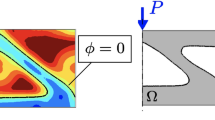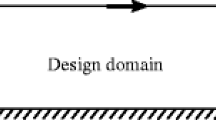Abstract
As the capabilities of additive manufacturing techniques increase, topology optimization provides a promising approach to design geometrically sophisticated structures. Traditional topology optimization methods aim at finding conceptual designs, but they often do not resolve sufficiently the geometry and the structural response such that the optimized designs can be directly used for manufacturing. To overcome these limitations, this paper studies the viability of the extended finite element method (XFEM) in combination with the level-set method (LSM) for topology optimization of three dimensional structures. The LSM describes the geometry by defining the nodal level set values via explicit functions of the optimization variables. The structural response is predicted by a generalized version of the XFEM. The LSM–XFEM approach is compared against results from a traditional Solid Isotropic Material with Penalization method for two-phase “solid–void” and “solid–solid” problems. The numerical results demonstrate that the LSM–XFEM approach describes crisply the geometry and predicts the structural response with acceptable accuracy even on coarse meshes.





















Similar content being viewed by others
References
Allaire G, Jouve F, Toader AM (2004) Structural optimization using sensitivity analysis and a level-set method. J Comput Phys 194(1):363–393
Babuška I, Melenk JM (1997) The partition of unity method. Int J Numer Methods Eng 40(4):727–758
Belytschko T, Black T (1999) Elastic crack growth in finite elements with minimal remeshing. Int J Numer Methods Eng 45(5):601–620
Bendsøe M (1989) Optimal shape design as a material distribution problem. Struct Multidiscip Optim 1(4):193–202
Bendsøe MP, Sigmund O (2003) Topology optimization: theory. Methods and applications. Springer, New York
Burger M, Hackl B, Ring W (2004) Incorporating topological derivatives into level set methods. J Comput Phys 194(1):344–362
Deaton J, Grandhi R (2013) A survey of structural and multidisciplinary continuum topology optimization: post 2000. Struct Multidiscip Optim p 1–38.doi: 10.1007/s00158-013-0956-z
van Dijk NP, Maute K, Langelaar M, van Keulen F (2013) Level-set methods for structural topology optimization: a review. Struct Multidiscip Optim 48(3):437–472
Dolbow J, Harari I (2009) An efficient finite element method for embedded interface problems. Int J Numer Math Eng 78:229–252
Duysinx P, Miegroet L, Jacobs T, Fleury C (2006) Generalized shape optimization using x-fem and level set methods. In: IUTAM symposium on topological design optimization of structures. springer, machines and materials, p 23–32
Eschenauer H, Kobelev V, Schumacher A (1994) Bubble method for topology and shape optimization of structures. Struct Multidiscip Optim 8(1):42–51
Fries T, Belytschko T (2010) The extended/generalized finite element method: an overview of the method and its applications. Int J Numer Methods Eng 84(3):253–304
Fries TP (2009) The intrinsic xfem for two-fluid flows. Int J Numer Methods Fluids 60(4):437–471
Gain AL, Paulino GH (2013) A critical comparative assessment of differential equation-driven methods for structural topology optimization. Struct Multidiscip Optim 48(4):685–710
Gerstenberger A, Wall WA (2008a) Enhancement of fixed-grid methods towards complex fluid–structure interaction applications. Int J Numer Methods Fluids 57(9):1227–1248
Gerstenberger A, Wall WA (2008b) An extended finite element method/Lagrange multiplier based approach for fluid–structure interaction. Comput Methods Appl Mech Eng 197:1699–1714
Guest J, Prévost J, Belytschko T (2004) Achieving minimum length scale in topology optimization using nodal design variables and projection functions. Int J Numer Methods Eng 61(2):238–254
Guest J, Asadpoure A, Ha SH (2011) Eliminating beta-continuation from heaviside projection and density filter algorithms. Struct Multidiscip Optim 44(4):443–453
Hansbo A, Hansbo P (2004) A finite element method for the simulation of strong and weak discontinuities in solid mechanics. Comput Methods Appl Mech Eng 193(33–35):3523–3540
Heroux M, Bartlett R, Hoekstra VHR, Hu J, Kolda T, Lehoucq R, Long K, Pawlowski R, Phipps E, Salinger A, Thornquist H, Tuminaro R, Willenbring J, Williams A (2003) An Overview of Trilinos. Tech. Rep. SAND2003-2927, Sandia National Laboratories
Herrero D, Martínez J, Martí P (2013) An implementation of level set based topology optimization using gpu. In: 10th World Congress on Structural and Multidisciplinary Optimization
Juntunen M, Stenberg R (2009) Nitsches method for general boundary conditions. Math Comput 78:1353–1374
Kreissl S, Maute K (2012) Levelset based fluid topology optimization using the extended finite element method. Struct Multidiscip Optim 46(3):311–326
Lang C, Makhija D, Doostan A, Maute K (2013) A simple and efficient preconditioning scheme for heaviside enriched XFEM. Computat Mech. arXiv:1312.6092
Lee P, Yang R, Maute K (2011) Lecture notes in applied and computational mechanics. An extended finite element method for the analysis of submicron heat transfer phenomena, multiscale methods in computational mechanics, vol 55. Springer, Dordrecht
Li L, Wang M, Wei P (2012) Xfem schemes for level set based structural optimization. Front Mech Eng 7(4):335–356
Makhija D, Maute K (2014) Numerical instabilities in level set topology optimization with the extended finite element method. Struct Multidiscip Optim 49(2):185–197
Maute K, Ramm E (1995) Adaptive topology optimization. Struct Multidiscip Optim 10(2):100–112
Maute K, Ramm E (1997) Adaptive topology optimization of shell structures. AIAA J 35(11):1767–1773
Maute K, Schwarz S, Ramm E (1998) Adaptive topology optimization of elastoplastic structures. Struct Multidiscip Optim 15(2): 81–91
Maute K, Kreissl S, Makhija D, Yang R (2011) Topology optimization of heat conduction in nano-composites. In: 9th World Congress on Structural and Multidisciplinary Optimization, Shizuoka, Japan
Meisel N, Gaynor A, Williams C, Guest J (2013) Multiple-material topology optimization of compliant mechanisms created via polyjet 3d printing. In: 24th Annual International Solid Freeform Fabrication Symposium An Additive Manufacturing Conference, August 12–14, 2013, Austin, TX
van Miegroet L, Duysinx P (2007) Stress concentration minimization of 2d filets using x-fem and level set description. Struct Multidiscip Optim 33(4–5):425–438
van Miegroet L, Moës N, Fleury C, Duysinx P (2005) Generalized shape optimization based on the level set method. In: 6th World Congress of Structural and Multidisciplinary Optimization
Nguyen T, Song J, Paulino G (2010) Challenges and advances in system reliability-based optimization of structural topology. In: structures congress 2010, pp 480–491
Nguyen T, Paulino G, Song J, Le C (2012) Improving multiresolution topology optimization via multiple discretizations. Int J Numer Methods Eng 92(6):507–530
Ning X, Pellegrino S (2012) Design of lightweight structural components for direct digital manufacturing. In: 53rd AIAA/ ASME/ASCE/AHS/ASC structures, structural dynamics and materials conference
Norato J, Bendsøe M, Haber R, Tortorelli D (2007) A topological derivative method for topology optimization. Struct Multidiscip Optim 33(4):375–386
Rozvany G (2009) A critical review of established methods of structural topology optimization. Struct Multidiscip Optim 37(3):217–237
Sethian J, Wiegmann A (2000) Structural boundary design via level set and immersed interface methods. J Comput Phys 163(2):489–528
Sigmund O (2001a) Design of multiphysics actuators using topology optimization-part I: one-material structures. Comput Methods Appl Mech Eng 190(49–50):6577–6604
Sigmund O (2001b) Design of multiphysics actuators using topology optimization-part II: two-material structures. Comput Methods Appl Mech Eng 190(49–50):6605–6627
Sigmund O (2007) Morphology-based black and white filters for topology optimization. Struct Multidiscip Optim 33(4–5):401–424
Sigmund O, Maute K (2013) Topology optimization approaches: a comparative review. Struct Multidiscip Optim
Sokolowski J, Zochowski A (1999) Topological derivatives for elliptic problems. Inverse Probl 15:123
Stenberg R (1995) On some techniques for approximating boundary conditions in the finite element method. J Comput Appl Math 63(1–3):139–148
Svanberg K (2002) A class of globally convergent optimization methods based on conservative convex separable approximations. SIAM J Optim 12(2):555–573
Wang MY, Wang X, Guo D (2003) A level set method for structural topology optimization. Comput Methods Appl Mech Eng 192(1–2):227–246
Wang S, Wang MY (2006) A moving superimposed finite element method for structural topology optimization. Int J Numer Methods Eng 65:1892–1922
Wei P, Wang M, Xing X (2010) A study on X-FEM in continuum structural optimization using a level set model. Comput Aided Design 42(8):708–719
Yamasaki S, Nomura T, Kawamoto A, Sato K, Nishiwaki S (2011) A level set-based topology optimization method targeting metallic waveguide design problems. Int J Numer Methods Eng 87(9):844–868
Yazid A, Abdelkader N, Abdelmadjid H (2009) A state-of-the-art review of the x-fem for computational fracture mechanics. Appl Math Model 33(12):4269–4282
Zhou M, Rozvany GIN (1991) The COC algorithm, part II: topological, geometrical and generalized shape optimization. Comput Methods Appl Mech Eng 89(1–3):309–336
Acknowledgments
The authors acknowledge the support of the National Science Foundation under grant EFRI-ODISSEI 1240374 and CBET 1246854. The opinions and conclusions presented in this paper are those of the authors and do not necessarily reflect the views of the sponsoring organization.
Author information
Authors and Affiliations
Corresponding author
Rights and permissions
About this article
Cite this article
Villanueva, C.H., Maute, K. Density and level set-XFEM schemes for topology optimization of 3-D structures. Comput Mech 54, 133–150 (2014). https://doi.org/10.1007/s00466-014-1027-z
Received:
Accepted:
Published:
Issue Date:
DOI: https://doi.org/10.1007/s00466-014-1027-z




